Effect of the Number of Circuits on a Finned-Tube Heat Exchanger Performance and Its Improvement by a Reversely Variable Circuitry
Abstract
:1. Introduction
2. Experimental Apparatus and Procedure
2.1. Experimental Apparatus
2.2. Test Procedure
3. Numerical Methods
4. Results and Discussion
4.1. Effect of the Circuit Number on the Evaporator and Condenser Performance
4.2. Reversely Variable Circuitry
- (i)
- the evaporator will hold four parallel circuits
- (ii)
- the condenser will exhibit as few circuits as possible
4.3. Comparison between Reversely Variable and Reversely Fixed FTHXs
5. Conclusions
- (1)
- The evaporator capacity first increased and then decreased as the circuit number increased, exhibiting the highest 2.61 kW with the optimal four-circuit scheme due to the trade-off between reduced overall heat transfer coefficient and increased temperature difference.
- (2)
- The condenser capacity decreased monotonously from 4.76 kW to 3.21 kW as the circuit number increased from one to six, because of the greatly reduced overall heat transfer coefficient.
- (3)
- The reversely variable circuitry was achieved with the combination of single-way valves and distributors, and exhibited four circuits in the evaporator mode and 1.5 circuits in the condenser mode, so as to better satisfy the respective needs in circuit number for both modes.
- (4)
- The reversely variable FTHX led to a better overall energy performance of the ASHP, with a 6.1% higher heating capacity than the four-circuit reversely fixed FTHX and a 3.9% larger cooling capacity than the 1.5-circuit FTHX.
Author Contributions
Funding
Institutional Review Board Statement
Informed Consent Statement
Data Availability Statement
Conflicts of Interest
References
- Sadeghianjahromi, A.; Wang, C. Heat transfer enhancement in fin-and-tube heat exchangers—A review on different mechanisms, Renew. Sust. Energ. Rev. 2021, 137, 110470. [Google Scholar] [CrossRef]
- Zhang, G.; Wang, B.; Li, X.; Shi, W.; Cao, Y. Review of experimentation and modeling of heat and mass transfer performance of fin-and-tube heat exchangers with dehumidification. Appl. Therm. Eng. 2019, 146, 701–717. [Google Scholar] [CrossRef]
- Bilen, K.; Cetin, M.; Gul, H.; Balta, T. The investigation of groove geometry effect on heat transfer for internally grooved tubes. Appl. Therm. Eng. 2009, 29, 753–761. [Google Scholar] [CrossRef]
- Andrade, F.; Moita, A.S.; Nikulin, A.; Moreira, A.L.N.; Santos, H. Experimental investigation on heat transfer and pressure drop of internal flow in corrugated tubes. Int. J. Heat Mass Transf. 2019, 140, 940–955. [Google Scholar] [CrossRef]
- Wang, Y.; Zhang, J.; Ma, Z. Experimental determination of single-phase pressure drop and heat transfer in a horizontal internal helically-finned tube. Int. J. Heat Mass Transf. 2017, 104, 240–246. [Google Scholar] [CrossRef]
- Siddique, M.; Alhazmy, M. Experimental study of turbulent single-phase flow and heat transfer inside a micro-finned tube. Int. J. Refrig. 2008, 31, 234–241. [Google Scholar] [CrossRef]
- Li, G.; Huang, L.; Tao, L. Experimental investigation of refrigerant condensation heat transfer characteristics in the horizontal microfin tubes. Appl. Therm. Eng. 2017, 123, 1484–1493. [Google Scholar] [CrossRef]
- Huang, D.; Zhao, R.; Liu, Y.; Yi, D. Effect of fin types of fan-supplied finned-tube heat exchanger on periodic frosting and defrosting performance of a residential air-source heat pump. Appl. Therm. Eng. 2014, 69, 251–260. [Google Scholar] [CrossRef]
- Liu, X.; Wang, M.; Liu, H.; Qian, S. Numerical analysis on heat transfer enhancement of wavy fin-tube heat exchangers for air-conditioning applications. Appl. Therm. Eng. 2021, 199, 117597. [Google Scholar] [CrossRef]
- Sarfraz, O.; Bach, C.K.; Bradshaw, C.R. Reduced order modeling for multi-circuit fin-and-tube heat exchangers with multiple identical circuit types. Int. J. Refrig. 2019, 106, 236–247. [Google Scholar] [CrossRef]
- Abu-Hamdeh, N.H.; Bantan, R.A.R.; Alimoradi, A. Heat transfer optimization through new form of pin type of finned tube heat exchangers using the exergy and energy analysis. Int. J. Refrig. 2020, 117, 12–22. [Google Scholar] [CrossRef]
- Guo, K.; Zhang, N.; Smith, R. Design optimisation of multi-stream plate fin heat exchangers with multiple fin types. Appl. Therm. Eng. 2018, 131, 30–40. [Google Scholar] [CrossRef]
- Sinha, A.; Chattopadhyay, H.; Lyengar, A.K.; Biswas, G. Enhancement of heat transfer in a fin-tube heat exchanger using rectangular winglet type vortex generators. Int. J. Heat Mass Transf. 2016, 101, 667–681. [Google Scholar] [CrossRef]
- Liang, S.; Wong, T.N.; Nathan, G.K. Numerical and experimental studies of refrigerant circuitry of evaporator coils. Int. J. Refrig. 2001, 24, 823–833. [Google Scholar] [CrossRef]
- Huang, D.; Chen, Q.; Yuan, X. Effect of circuit number on the indoor coil serving as both condenser and evaporator in heat pump. J. Xi’an Jiaotong Univ. 2007, 41, 543–548. (In Chinese) [Google Scholar]
- Bahman, A.M.; Groll, E.A. Application of interleaved circuitry to improve evaporator effectiveness and COP of a packaged AC system. Int. J. Refrig. 2017, 79, 114–129. [Google Scholar] [CrossRef]
- Saleem, S.; Bradshaw, C.R.; Bach, C.K. Validation of a multi-circuit heat exchanger model for evaluating the effect of refrigerant circuitry on cross-fin conduction in evaporator mode. Int. J. Refrig. 2021, 131, 623–633. [Google Scholar] [CrossRef]
- Yashar, D.A.; Lee, S.; Domanski, P.A. Rooftop air-conditioning unit performance improvement using refrigerant circuitry optimization. Appl. Therm. Eng. 2015, 83, 81–87. [Google Scholar] [CrossRef]
- Ishaque, S.; Kim, M.H. Numerical modeling of an outdoor unit heat exchanger for residential heat pump systems with nonuniform airflow and refrigerant distribution. Int. J. Heat Mass Transf. 2021, 175, 121323. [Google Scholar] [CrossRef]
- Sim, J.; Lee, H.; Jeong, J.H. Optimal design of variable-path heat exchanger for energy efficiency improvement of air-source heat pump system. Appl. Energ. 2021, 290, 116741. [Google Scholar] [CrossRef]
- Wang, F.; Zhao, R.; Ma, C.; Huang, D.; Qu, Z. Reversely-variable circuitry for finned-tube heat exchanger in air source heat pump to enhance its overall energy performance. Int. J. Refrig. 2022, 142, 48–57. [Google Scholar] [CrossRef]
- Moffat, R.J. Describing the uncertainties in experimental results. Exp. Therm. Fluid Sci. 1998, 1, 3–17. [Google Scholar] [CrossRef]
- Domanski, P.A. Simulation of an evaporator with nonuniform one-dimensional air distribution. ASHRAE Trans. 1991, 97, 793–802. [Google Scholar]
- Song, X.; Huang, D.; Liu, X.; Chen, Q. Effect of non-uniform air velocity distribution on evaporator performance and its improvement on a residential air conditioner. Appl. Therm. Eng. 2012, 40, 284–293. [Google Scholar] [CrossRef]
- Thome, J.R. Update on advances in flow pattern based two-phase heat transfer models. Exp. Therm. Fluid Sci. 2005, 29, 341–349. [Google Scholar] [CrossRef]
- Shah, M.M. General correlation for heat transfer during film condensation inside pipes. Int. J. Heat Mass Transf. 1979, 22, 547–556. [Google Scholar] [CrossRef]
- ASHRAE. ASHRAE Handbook: Fundamentals Volume; American Society of Heating, Refrigerating and Air Conditioning Engineers, Inc.: Atlanta, GA, USA, 2001; pp. 3–14. [Google Scholar]
- Müller-Steinhagen, H.; Heck, H.K. A simple friction pressure drop correlation for two-phase flow in pipes. Chem. Eng. Process 1986, 20, 297–308. [Google Scholar] [CrossRef]
- Chisholm, D. Two-Phase Flow in Pipelines and Heat Exchangers; George Godwin: London, UK, 1983; pp. 304–305. [Google Scholar]
- Idelchik, I.E. Handbook of Hydraulic Resistance, 2nd ed.; Hemisphere: New York, NY, USA, 1986; pp. 640–641. [Google Scholar]
- Wang, C.C.; Jang, J.Y.; Chiou, N.F. A heat transfer and friction correlation for wavy fin-and-tube heat exchangers. Int. J. Heat Mass Transf. 1999, 42, 1919–1924. [Google Scholar] [CrossRef]

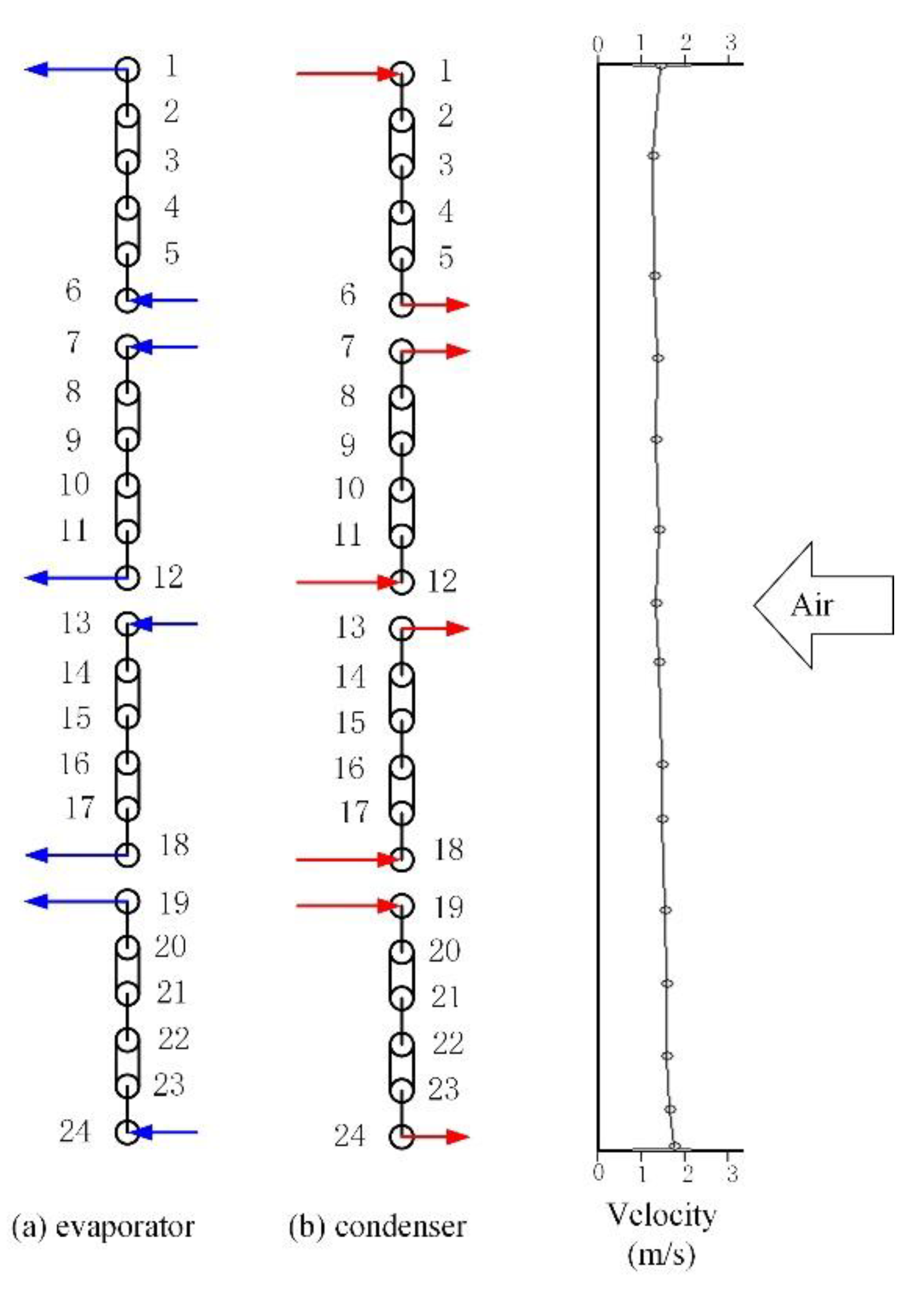
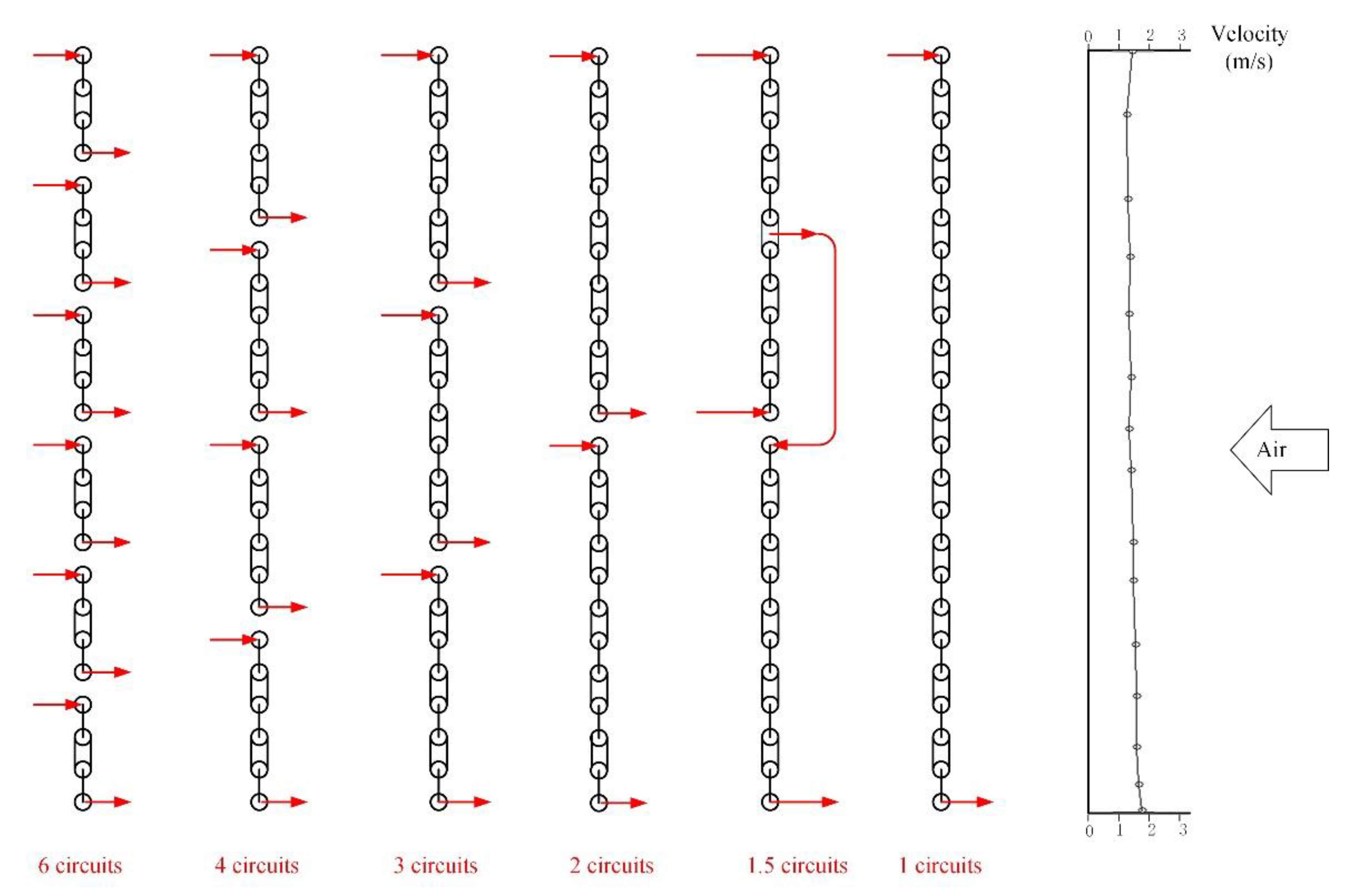

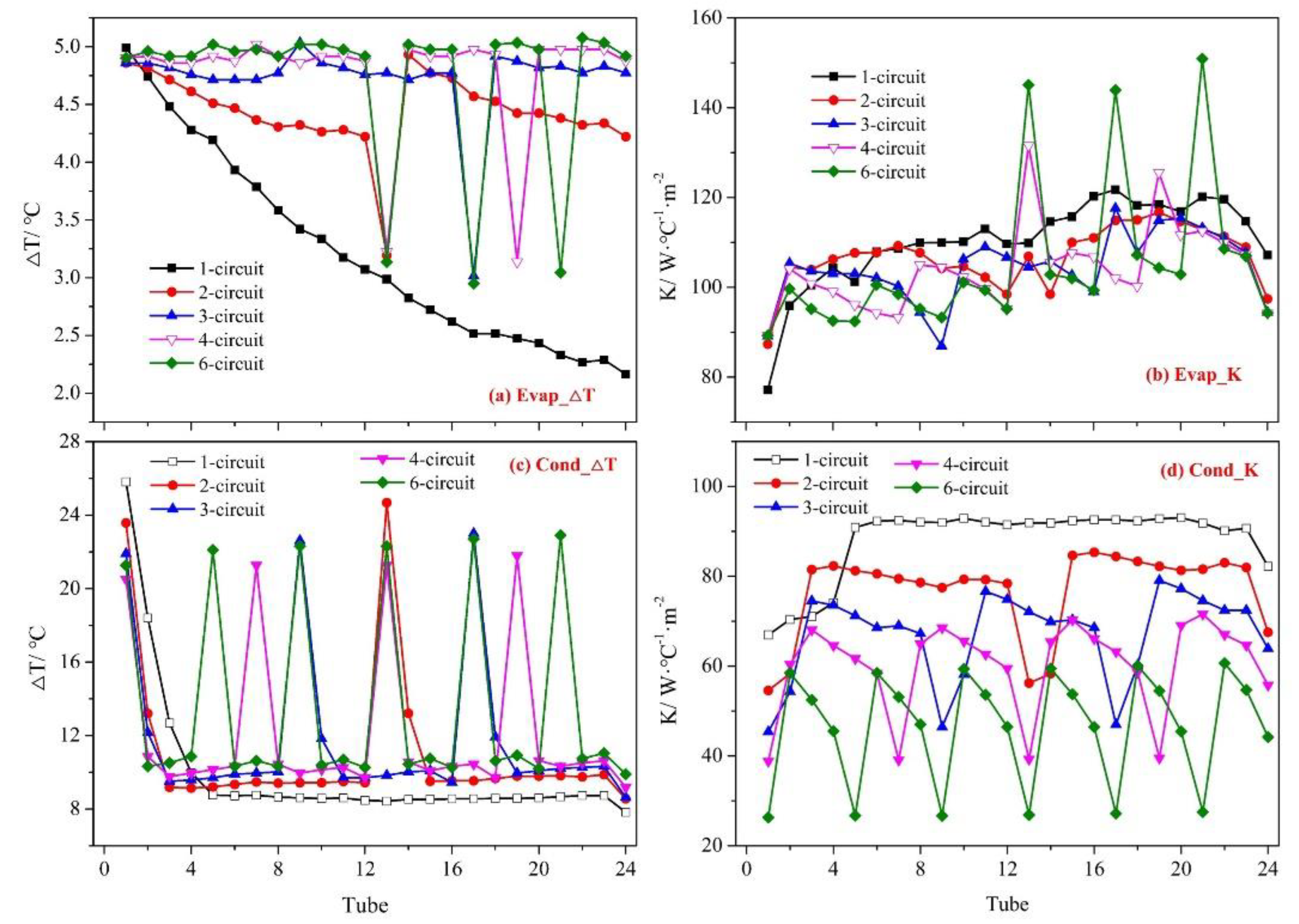
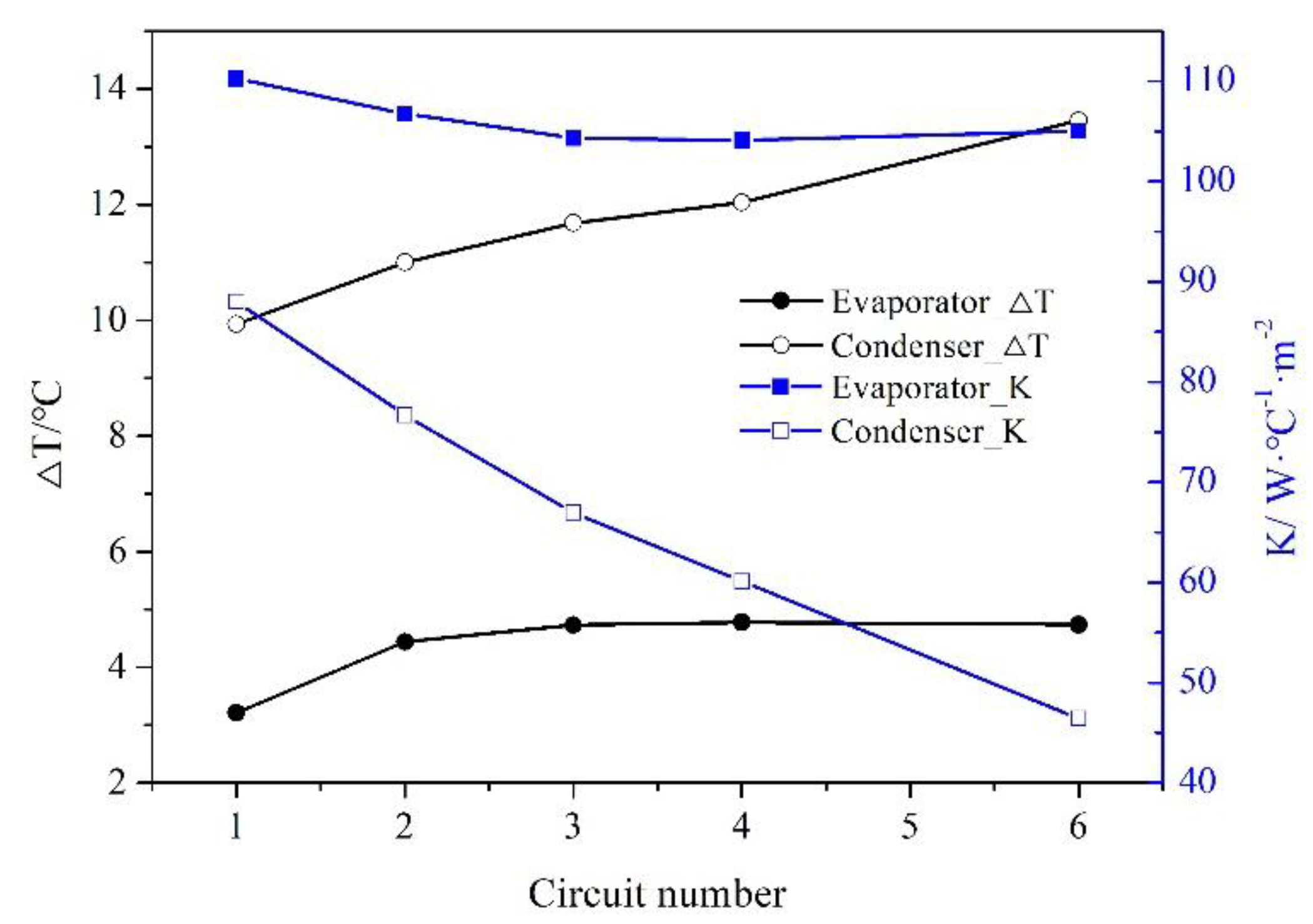

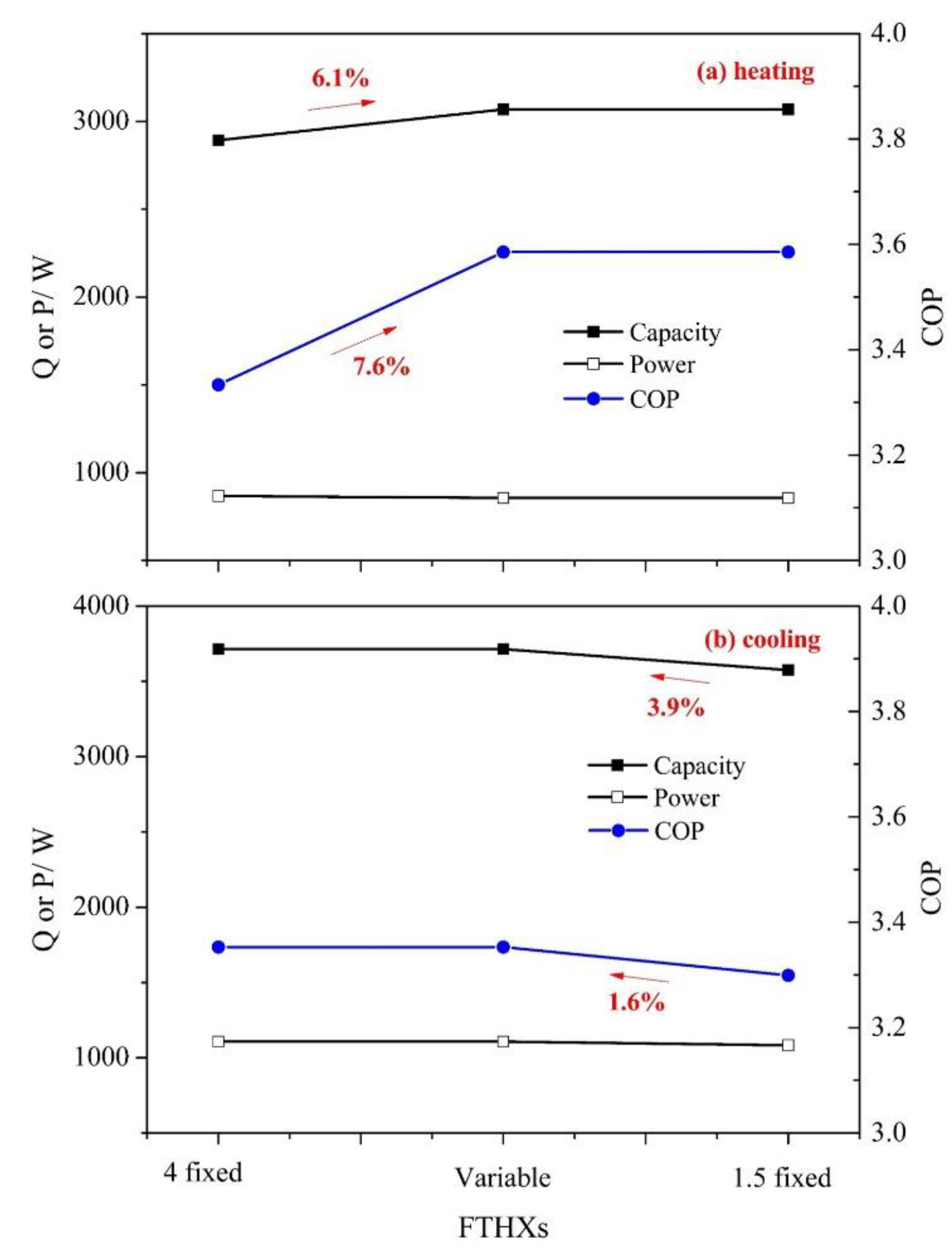
| Item | Information | |
|---|---|---|
| Indoor coil | Tube number | 34, 18 in the 1st row and 16 in the 2nd row |
| Outer diameter | 5 mm | |
| Tube length | 630 mm | |
| Fin pitch | 1.4 mm | |
| Outdoor coil | Tube number | 24 in one row |
| Outer diameter | 7 mm | |
| Tube length | 770 mm | |
| Fin pitch | 1.25 mm | |
| Electronic expansion valve | DunAn DPF1.3C-B059 | |
| Compressor | GSD098CKQA6JT6B | |
| Refrigerant | R32 with 570 g charge | |
| Conditions | Outdoor Temp. (Dry/Wet Bulb) | Indoor Temp. (Dry/Wet Bulb) | Compressor Speed | EEV Target Discharge Temp. | Out FTHX Air Flowrate |
|---|---|---|---|---|---|
| Rated cooling | 35/24 °C | 27/19 °C | 55 Hz | 79 °C | 1800 m3/h |
| Rated heating | 7/6 °C | 20/15 °C | 90 Hz | 73 °C | 2400 m3/h |
| Modes | Condenser | Evaporator | ||
|---|---|---|---|---|
| Refrigerant | Inlet temperature/°C | 48.5 | Outlet sat. temperature/°C | 0.8 |
| Inlet superheat/°C | 34.8 | Outlet quality | 0.98 | |
| Subcooling/°C | 1.3 | Inlet quality | 0.15 | |
| Air | Air inlet temperature/°C | 35 | Air inlet temperature/°C | 7 |
| Air inlet pressure/MPa | 0.101 | Air inlet pressure/MPa | 0.101 | |
| Air inlet relative humidity | 0.40 | Air inlet relative humidity | 0.86 | |
| Tube | Experimental | Numerical | Deviation |
|---|---|---|---|
| 1 | 81.9 °C | 83.3 °C | +1.4 °C |
| 12 | 84.0 °C | 83.3 °C | −0.7 °C |
| 18 | 75.5 °C | 83.3 °C | +7.8 °C |
| 19 | 78.5 °C | 83.3 °C | +4.8 °C |
| 3 | 47.7 °C | 48.5 °C | +0.8 °C |
| 10 | 47.8 °C | 48.5 °C | +0.7 °C |
| 16 | 41.7 °C | 48.5 °C | +6.8 °C |
| 21 | 47.6 °C | 48.5 °C | +0.9 °C |
| 6 | 46.2 °C | 48.5 °C | +2.3 °C |
| 7 | 43.7 °C | 47.1 °C | +3.4 °C |
| 13 | 37.0 °C | 46.5 °C | +9.5 °C |
| 24 | 47.0 °C | 45.6 °C | −1.4 °C |
| Capacity | 3.77 kW | 3.85 kW | +2.1% |
| Modes | Evaporator | Condenser |
|---|---|---|
| Prototype |  | |
| Variable | On | Off |
| 4-circuit fixed | On | On |
| 1.5-circuit fixed | Off | Off |
Publisher’s Note: MDPI stays neutral with regard to jurisdictional claims in published maps and institutional affiliations. |
© 2022 by the authors. Licensee MDPI, Basel, Switzerland. This article is an open access article distributed under the terms and conditions of the Creative Commons Attribution (CC BY) license (https://creativecommons.org/licenses/by/4.0/).
Share and Cite
Zhao, R.; Wang, Z.; Sun, Y.; Wang, F.; Huang, D. Effect of the Number of Circuits on a Finned-Tube Heat Exchanger Performance and Its Improvement by a Reversely Variable Circuitry. Appl. Sci. 2022, 12, 8960. https://doi.org/10.3390/app12188960
Zhao R, Wang Z, Sun Y, Wang F, Huang D. Effect of the Number of Circuits on a Finned-Tube Heat Exchanger Performance and Its Improvement by a Reversely Variable Circuitry. Applied Sciences. 2022; 12(18):8960. https://doi.org/10.3390/app12188960
Chicago/Turabian StyleZhao, Rijing, Zengpeng Wang, Yu Sun, Fei Wang, and Dong Huang. 2022. "Effect of the Number of Circuits on a Finned-Tube Heat Exchanger Performance and Its Improvement by a Reversely Variable Circuitry" Applied Sciences 12, no. 18: 8960. https://doi.org/10.3390/app12188960
APA StyleZhao, R., Wang, Z., Sun, Y., Wang, F., & Huang, D. (2022). Effect of the Number of Circuits on a Finned-Tube Heat Exchanger Performance and Its Improvement by a Reversely Variable Circuitry. Applied Sciences, 12(18), 8960. https://doi.org/10.3390/app12188960





